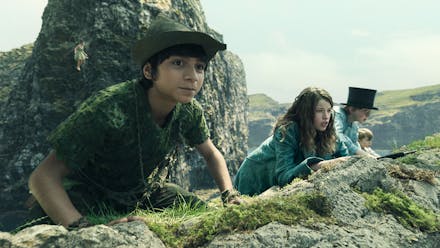Of the many things director David Lowery gets right about Peter Pan, the most important is this: it’s never really been about Peter himself. While the boy who never grows up was afforded sole headline billing in Disney’s 1953 adaptation, the 1911 novel version of J.M. Barrie’s tale was titled Peter And Wendy — and in Lowery’s Disney live-action reimagining, Wendy Darling finally gets her title-role status.
Peter Pan & Wendy is less a reframing, then, than an acknowledgement that this was always Wendy’s story first: that of a girl preparing to take a first step out of childhood, who gets to experience an awfully big adventure for a night when Peter Pan shows up at her window and whisks her and her brothers off to a fantasy land. Lowery was previously behind Disney’s emotional Pete’s Dragon remake, but is more associated with metaphysical odysseys like The Green Knight and A Ghost Story; this is perhaps the hippest director-to-kids’-movie pairing since Spike Jonze wondered Where The Wild Things Are. The director revels in the thematic meat of Barrie’s story, invested not only in Wendy’s impending coming-of-age, but the haunting undercurrents of children who don’t get to grow up, and adults whose inner children have died.

That thoughtfulness extends to the filmmaking itself. Early on, Lowery’s camera ascends through the hustle and bustle of the Darling household in a sweeping tracking shot; the children’s flight towards Neverland is vividly captured, the kids half soaring, half swimming towards Big Ben, plunging into a timeless void in a thrillingly experimental flourish. When restaging iconic images — Peter chasing his shadow around the children’s bedroom; Hook facing down a monstrous (now kaiju-sized) croc — there’s clear consideration in how it’s all interpreted. And while Neverland itself lacks the heightened colours of the 1953 version, its open expanses and overgrown-playground sets are beautifully captured by Bojan Bazelli’s earthy cinematography.
The emotional landing is nailed entirely.
Ironically, though, Peter Pan & Wendy is lacking in youthful spirit. While Lowery is clearly at home with the melancholic elements of the narrative, his grasp on whimsy isn’t nearly as strong. Rather than kicking into adventure mode once the kids get to Neverland, the film softens into a baggy, draggy middle act. It doesn’t help that Jude Law’s Captain Hook feels disappointingly miscast. Despite a thrilling entrance — literally shooting his way into the film — he’s simply not enough fun: not the preening villain of the 1953 film, nor the pantomime portrayal of Dustin Hoffman in Hook. Like his limp hairpiece, Law’s performance falls oddly flat, struggling to live up to lines as delicious as, “I’ve found you guilty of being a child!” When a dramatic thread kicks in that connects Hook and Peter in fascinating ways, Law is excellent; less so with the yo-ho-ho.

Sad to say, newcomer Alexander Molony can’t quite fill Peter’s pointy green boots either. It’s a monumental ask, to play endlessly effervescent energy, undercut with the ache of never getting to grow beyond that — Molony is better at the latter, but his performance lacks the effortless snappiness, the boyish obnoxiousness meant to define Peter’s reckless spirit. Combined with Law’s internalised performance, it all feels a bit small — witnessing a chapter in the pair’s eternal battle is rarely as riveting as it should be, and likely won’t hold kids’ attention.
Much more assured, though, is Ever Anderson’s Wendy — not just the emotional heart of the story, but joyously stepping up as an action hero when the film finally shifts into a more playful gear in its swashbuckling finale. She perfectly captures that precipice of adolescence, not ready to put the wooden sword down yet, but sensing a new door ready to open, too. It’s a message beautifully delivered in a pair of flip-book montages that bookend the film — in fact, the emotional landing is nailed entirely. It’s emblematic of an adaptation that, for all its well-executed ideas, feels a little too keen to grow up.

